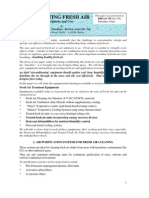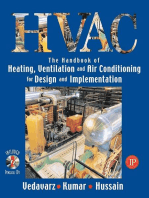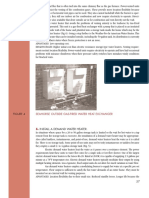HVAC-PLUMBING-GUIDE-BOOK - Cleaned (1) - Part47
HVAC-PLUMBING-GUIDE-BOOK - Cleaned (1) - Part47
Uploaded by
gfhf dgdOriginal Description:
Original Title
Copyright
Available Formats
Share this document
Did you find this document useful?
Is this content inappropriate?
Report this DocumentCopyright:
Available Formats
HVAC-PLUMBING-GUIDE-BOOK - Cleaned (1) - Part47
HVAC-PLUMBING-GUIDE-BOOK - Cleaned (1) - Part47
Uploaded by
gfhf dgdCopyright:
Available Formats
bon dioxide, or a mixture of gaseous pollutants such as tobacco smoke, cooking odors, and VOCs.
For
the most part, the manual controls tend to be most appropriate for local exhaust fans and the more sophis-
ticated automatic controls are appropriate for whole-house ventilation systems.
ADVANTAGES: Manual controls are relatively inexpensive and reliable. Automatic controls do not rely upon
the user.
DISADVANTAGES: Manual controls rely upon the user for proper control. Automatic controls are more
expensive and can fall out of calibration resulting in either insufficient or excessive ventilation air quantities.
5. INSTALL A FORCED-AIR ZONING SYSTEM.
Forced-air zoning systems utilize thermostats in conjunction with motorized dampers in individual supply
ducts to different control zones (Fig. 4). By varying the air flow in response to the zone thermostat, a sin-
gle air conditioning and/or heating system can be used to meet the varying needs of multiple zones. These
systems are most easily installed in a new installation, but can be retrofitted into an existing system. Care
must be taken to either bypass extra air or oversize the ductwork to assure that central system air flow
does not drop below the design minimum when only one or two zones are calling for air and all other
zones are closed. There are several manufacturers of this type of system including Research Products
Corporation, Carrier, Honeywell/Trol-A-Temp and Durazone.
ADVANTAGES: Achieves the energy saving and improved comfort benefits of zoning with a central forced-
air system.
DISADVANTAGES: High initial cost. Systems need to be carefully designed to assure that minimum air flow
requirements are met under all operating conditions.
FIGURE 4 FORCED-AIR ZONING SYSTEM
FURTHER READING
Comfort, Air Quality, and Efficiency by Design, Manual RS, Air Conditioning Contractors Association, 1997.
Understanding Ventilation, John Bower, The Healthy House Institute, 1995.
45
You might also like
- Introduction to Fly-By-Wire Flight Control SystemsFrom EverandIntroduction to Fly-By-Wire Flight Control SystemsRating: 5 out of 5 stars5/5 (1)
- Brochures WZ-EDocument16 pagesBrochures WZ-EHector TosarNo ratings yet
- Project On ACDocument82 pagesProject On ACMahesh DondapatiNo ratings yet
- Introducton On AC SystemsDocument20 pagesIntroducton On AC SystemsmudarNo ratings yet
- Daikin Parallel Fan Powered VAV Systems AppGuide AG 31-018 LRDocument2 pagesDaikin Parallel Fan Powered VAV Systems AppGuide AG 31-018 LRSambhav TiwariNo ratings yet
- Ventilation: MDM Nurul Aini/Qus 3206Document22 pagesVentilation: MDM Nurul Aini/Qus 3206Anisha NaiduNo ratings yet
- Ventilation: MDM Nurul Aini/Qus 3206Document22 pagesVentilation: MDM Nurul Aini/Qus 3206Anonymous bymBquNo ratings yet
- Hvac Selection and Ccs in Pharmaceutical IndustryDocument14 pagesHvac Selection and Ccs in Pharmaceutical IndustryKenny ObayomiNo ratings yet
- HVAC Course PDFDocument273 pagesHVAC Course PDFliliNo ratings yet
- Air ConditioningDocument35 pagesAir Conditioningali abuNo ratings yet
- All-Air SystemsDocument62 pagesAll-Air SystemsmarleythejckrssllNo ratings yet
- Air Distribution System Vav VRVDocument3 pagesAir Distribution System Vav VRVsiva ramanNo ratings yet
- Solutions Guide AirzoneDocument16 pagesSolutions Guide Airzoneljrojas2011No ratings yet
- K-Ecbc 2018: Comfort System & Controls - WebinarDocument60 pagesK-Ecbc 2018: Comfort System & Controls - WebinarJotham King DennisNo ratings yet
- BU RESEARCH PDF Di Pa FinalDocument26 pagesBU RESEARCH PDF Di Pa FinalMichelle VillarandaNo ratings yet
- Split Systems May Include The Following Configurations:: © J. Paul Guyer, 2009 12Document2 pagesSplit Systems May Include The Following Configurations:: © J. Paul Guyer, 2009 12zolalkkNo ratings yet
- M147 Design Options For HVAC Distribution SystemDocument58 pagesM147 Design Options For HVAC Distribution Systemstressfree123No ratings yet
- BOGE - Specifying Compressed Air For Healthcare - White Paper - Jan 2016 PDFDocument8 pagesBOGE - Specifying Compressed Air For Healthcare - White Paper - Jan 2016 PDFAndrew MaverickNo ratings yet
- Building Services - Iv - Mechanical Transport, BMS, Communication and HVACDocument45 pagesBuilding Services - Iv - Mechanical Transport, BMS, Communication and HVACAjay JainNo ratings yet
- Types of HVAC SystemsDocument18 pagesTypes of HVAC SystemsIsrael raju2003No ratings yet
- Proper Design ConsiderationsxDocument4 pagesProper Design ConsiderationsxLTE002No ratings yet
- Abstract Fahad Riaz 034Document13 pagesAbstract Fahad Riaz 034Saim TufailNo ratings yet
- Comfort Control PrinciplesDocument45 pagesComfort Control PrinciplesThanh ThuanNo ratings yet
- HVAC SystemDocument21 pagesHVAC Systemtinkusk24No ratings yet
- Daikin VAV With Reheat Systems AppGuide AG31-021 LRDocument2 pagesDaikin VAV With Reheat Systems AppGuide AG31-021 LRMIGUELNo ratings yet
- Air-Conditioning System DesignDocument42 pagesAir-Conditioning System DesignRaj Verma100% (2)
- F2976-13 Standard Practice For Determining The Field PerformanceDocument6 pagesF2976-13 Standard Practice For Determining The Field PerformanceRafael Obusan IINo ratings yet
- Aircycle 3.1 - Heat Recovery UnitDocument6 pagesAircycle 3.1 - Heat Recovery UnitValentin MalihinNo ratings yet
- SV: Phạm Tấn Phát MSSV: 197KN523320Document29 pagesSV: Phạm Tấn Phát MSSV: 197KN523320Phạm Tấn PhátNo ratings yet
- Efficient Compressed Air SystemsDocument4 pagesEfficient Compressed Air SystemsGurusumiNo ratings yet
- CA 2006-3 TipsheetcaefficiencymeasuresDocument3 pagesCA 2006-3 TipsheetcaefficiencymeasuresrahmatNo ratings yet
- Ventilation MechanismDocument13 pagesVentilation Mechanismshreyash guptaNo ratings yet
- GA30-90C BrochureDocument12 pagesGA30-90C BrochureSunil KambleNo ratings yet
- Basic Fan SelectionDocument4 pagesBasic Fan Selectioncem_kamalNo ratings yet
- Inventor of The Thrust Ventilation SystemDocument4 pagesInventor of The Thrust Ventilation SystemKrishna PATELNo ratings yet
- Variable Air Volume SystemDocument28 pagesVariable Air Volume SystemNishanth N NairNo ratings yet
- Seminar On AC SystemDocument33 pagesSeminar On AC SystemHassan Elattar0% (1)
- ECM4 Technical Information CompositeDocument8 pagesECM4 Technical Information CompositeninenergyNo ratings yet
- Seminar On AC SystemDocument33 pagesSeminar On AC SystemJagadish SahuNo ratings yet
- Ventilation Planning OlDocument97 pagesVentilation Planning Olenjam yasankNo ratings yet
- Air HandlerDocument15 pagesAir HandlerShashank BijweNo ratings yet
- NT 3036 - Handout 1 - Introduction To Air ConditioningDocument23 pagesNT 3036 - Handout 1 - Introduction To Air ConditioningAnonymous 1Z5K9QXNo ratings yet
- Chap 10 HvacDocument30 pagesChap 10 HvacVikrant HaribhaktaNo ratings yet
- Breathing Air Compressors Verticus 5 by Bauer Kompressoren GMBHDocument4 pagesBreathing Air Compressors Verticus 5 by Bauer Kompressoren GMBHindahbinaservicesNo ratings yet
- Hvac 4Document3 pagesHvac 4zolalkkNo ratings yet
- L Series: Application and Design GuidelinesDocument3 pagesL Series: Application and Design GuidelinessajuhereNo ratings yet
- Treated Fresh Air Guidelines by BryairDocument13 pagesTreated Fresh Air Guidelines by BryairRajan100% (1)
- Introduction To Pneumatic SlideDocument23 pagesIntroduction To Pneumatic SlideMuhammad Danish HakimNo ratings yet
- USGUIDE1 AirCompGuide GettingMostForYourMoney 0Document8 pagesUSGUIDE1 AirCompGuide GettingMostForYourMoney 0Adeilton CabocloNo ratings yet
- Commissioning Commercial KitchensDocument3 pagesCommissioning Commercial KitchensMoh'd KhadNo ratings yet
- 82191C Brochure APPL ADV200-HVAC ENDocument20 pages82191C Brochure APPL ADV200-HVAC ENbaros07No ratings yet
- M06-017 - Design Options For HVAC Distribution Systems - USDocument68 pagesM06-017 - Design Options For HVAC Distribution Systems - USaxelNo ratings yet
- HVAC - Guide To Demand Control VentilationDocument39 pagesHVAC - Guide To Demand Control VentilationDavid GeniacNo ratings yet
- Safari - 2019年4月11日 09:12Document1 pageSafari - 2019年4月11日 09:12Prince MarcoNo ratings yet
- Lecture No.12 (Systems)Document10 pagesLecture No.12 (Systems)Mohsen HassanNo ratings yet
- (FM CBMTEC) 240123#catalog For Air Compressors and Vacuum PlantsDocument6 pages(FM CBMTEC) 240123#catalog For Air Compressors and Vacuum PlantsslimaniNo ratings yet
- The Handbook of Heating, Ventilation and Air Conditioning (HVAC) for Design and ImplementationFrom EverandThe Handbook of Heating, Ventilation and Air Conditioning (HVAC) for Design and ImplementationRating: 1 out of 5 stars1/5 (1)
- Practical, Made Easy Guide To Building, Office And Home Automation Systems - Part OneFrom EverandPractical, Made Easy Guide To Building, Office And Home Automation Systems - Part OneNo ratings yet
- Pages From Pages From Hvac-Equations-Data-And-Rules-Of-Thumb - pdf02Document1 pagePages From Pages From Hvac-Equations-Data-And-Rules-Of-Thumb - pdf02gfhf dgdNo ratings yet
- HVAC-PLUMBING-GUIDE-BOOK - Cleaned (1) - Part49Document1 pageHVAC-PLUMBING-GUIDE-BOOK - Cleaned (1) - Part49gfhf dgdNo ratings yet
- HVAC-PLUMBING-GUIDE-BOOK - Cleaned (1) - Part57 PDFDocument1 pageHVAC-PLUMBING-GUIDE-BOOK - Cleaned (1) - Part57 PDFgfhf dgdNo ratings yet
- HVAC-PLUMBING-GUIDE-BOOK - Cleaned (1) - Part53Document1 pageHVAC-PLUMBING-GUIDE-BOOK - Cleaned (1) - Part53gfhf dgdNo ratings yet
- HVAC-PLUMBING-GUIDE-BOOK - Cleaned (1) - Part54 PDFDocument1 pageHVAC-PLUMBING-GUIDE-BOOK - Cleaned (1) - Part54 PDFgfhf dgdNo ratings yet
- HVAC-PLUMBING-GUIDE-BOOK - Cleaned (1) - Part59Document1 pageHVAC-PLUMBING-GUIDE-BOOK - Cleaned (1) - Part59gfhf dgdNo ratings yet
- HVAC-PLUMBING-GUIDE-BOOK - Cleaned (1) - Part52Document1 pageHVAC-PLUMBING-GUIDE-BOOK - Cleaned (1) - Part52gfhf dgdNo ratings yet
- HVAC-PLUMBING-GUIDE-BOOK - Cleaned (1) - Part58Document1 pageHVAC-PLUMBING-GUIDE-BOOK - Cleaned (1) - Part58gfhf dgdNo ratings yet
- HVAC-PLUMBING-GUIDE-BOOK - Cleaned (1) - Part78 PDFDocument1 pageHVAC-PLUMBING-GUIDE-BOOK - Cleaned (1) - Part78 PDFgfhf dgdNo ratings yet
- HVAC-PLUMBING-GUIDE-BOOK - Cleaned (1) - Part7Document1 pageHVAC-PLUMBING-GUIDE-BOOK - Cleaned (1) - Part7gfhf dgdNo ratings yet
- HVAC-PLUMBING-GUIDE-BOOK - Cleaned (1) - Part77 PDFDocument1 pageHVAC-PLUMBING-GUIDE-BOOK - Cleaned (1) - Part77 PDFgfhf dgdNo ratings yet
- HVAC-PLUMBING-GUIDE-BOOK - Cleaned (1) - Part76 PDFDocument1 pageHVAC-PLUMBING-GUIDE-BOOK - Cleaned (1) - Part76 PDFgfhf dgdNo ratings yet
- District Cooling System DCS - Part3Document1 pageDistrict Cooling System DCS - Part3gfhf dgdNo ratings yet
- Wavistrong Installation Guide - Part38Document1 pageWavistrong Installation Guide - Part38gfhf dgdNo ratings yet
- Wavistrong Installation Guide - Part37Document1 pageWavistrong Installation Guide - Part37gfhf dgdNo ratings yet
- Wavistrong Installation Guide - Part36Document1 pageWavistrong Installation Guide - Part36gfhf dgdNo ratings yet
- Wavistrong Installation Guide - Part39Document1 pageWavistrong Installation Guide - Part39gfhf dgdNo ratings yet
- Wavistrong Installation Guide - Part34Document1 pageWavistrong Installation Guide - Part34gfhf dgdNo ratings yet
- Wavistrong Installation Guide - Part32Document1 pageWavistrong Installation Guide - Part32gfhf dgdNo ratings yet
- Wavistrong Installation Guide - Part35Document1 pageWavistrong Installation Guide - Part35gfhf dgdNo ratings yet
- Wavistrong Installation Guide - Part24Document1 pageWavistrong Installation Guide - Part24gfhf dgdNo ratings yet
- Wavistrong Installation Guide - Part26Document1 pageWavistrong Installation Guide - Part26gfhf dgdNo ratings yet

















































































